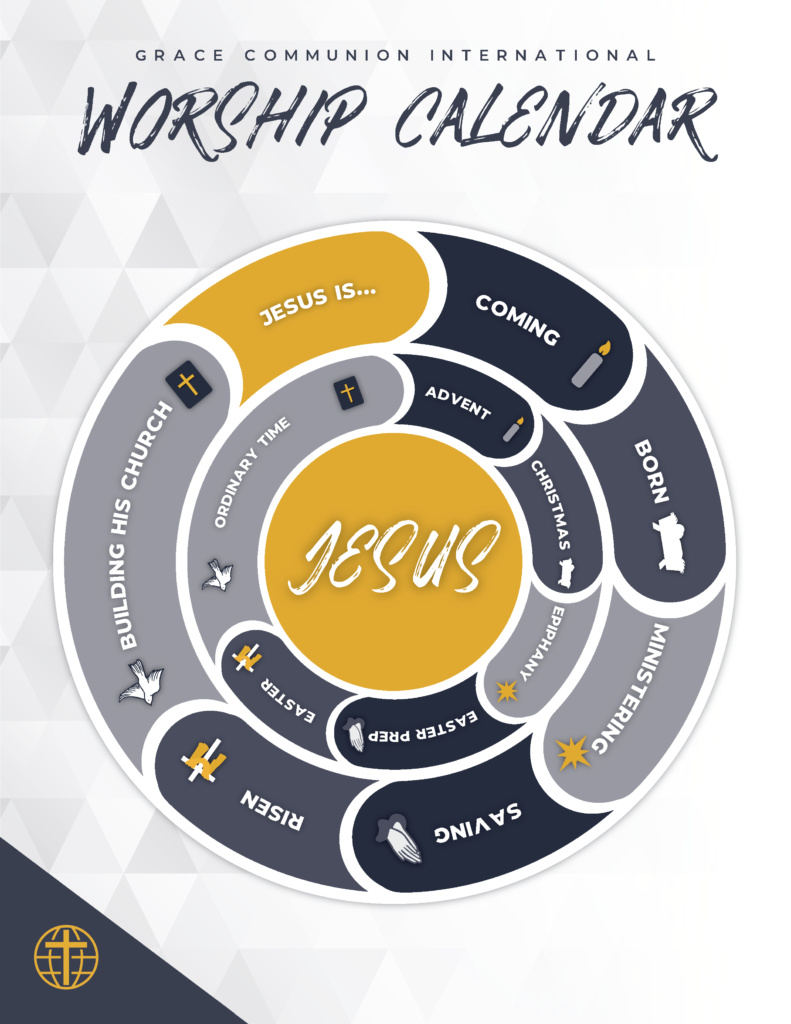Sermon for March 22, 2020
1 Samuel 16:1-13 • Psalm 23:1-6 • Ephesians 5:8-14 • John 9:1-41
The theme this week is seeing by God’s light. In 1 Samuel 16, God tells Samuel to see with God’s eyes and vision as Samuel goes to anoint the new king – to look beyond the outward appearance of a man like Saul. In Psalm 23, the poet talks about walking by God’s light even in the greatest darkness. In Ephesians 5, Paul encourages this fledgling faith community to walk in the light of Christ rather than their old darkness. Our sermon, Jesus and the Invisible Man, is based on John 9. Jesus brings metaphor and concrete reality together by declaring himself to be the light, then giving light to the eyes of the man born blind.
Jesus and the Invisible Man
John 9:1-41 ESV
The Gospel reading this week is especially long. If your fellowship is used to having a Gospel reading, have someone read this passage before you start the sermon. Otherwise, it will be referenced and summarized throughout the sermon and people can follow along in their own Bibles.
We’ve all experienced “invisible” people in our lives. People we don’t bear any ill will toward, or dislike, but people we and most of society disregard. The teenage cashier at the coffee shop, the homeless man asleep on the park bench, the person in the next seat on the bus.
It’s not that we are selfish and disregarding, it’s just that society, as it rolls along, ignores those who are inconvenient and pushes them aside. They become part of the scenery.

In Jesus’ day, people with disabilities like the man born blind in John 9 were part of this invisible category. They were completely dependent on the kindness of the society around them—there were no social services or other support systems. They would beg at the gates and the synagogue, wherever people were gathered.
Folks back then were so worried about their own survival that it was difficult to help the invisible people. They did—in some ways better than we do—but survival for a person with a disability was brutal and meager.
With this context in mind, our passage today throws emotional punches from the start. Turn with me to John 9.
As he passed by, he saw a man blind from birth. (John 9:1 ESV)
Jesus “saw” him. Jesus stops in his very important and increasingly dangerous journey to “see” an invisible person. The contrast is even more stark when we think that this man, who could never see, was seen by the Lord.
What follows is one of the most confusing he said/she said scenarios of Jesus’ career. First, Jesus sees and heals the man with mud he made from his own spit. Then Jesus tells him to wash in a nearby pool and then he takes off.
The locals see the guy and realize he’s the one who was born blind and now he can see. They ask him over and over what happened, and he tells them. They ask him where Jesus is, and he says he doesn’t know.
They bring the recently blind man to the Pharisees to make sense of it, which spurs a theological debate among them. How can someone who doesn’t follow our traditions be from God? How can someone who is not from God do stuff like this?
They demand the exasperated recently blind man tell them what happened, and he essentially says: “I don’t know how it worked, I don’t even know who the guy was really, but I know I can see!!!”
They ask his parents what’s going on and they jump out of the conversation quickly so they won’t get in trouble. They come at him again and then cast him out of the synagogue which is basically like cutting him out of the community.
Jesus finds the man and reveals who he is to him in a one-on-one conversation.
Read this fast enough and it sounds like a slapstick comedy with characters running back and forth across the screen.
- aren’t you the blind guy?
- Who did this to you?
- I’m not sure—I don’t know!
- Is that your son? We don’t want to get involved!
- We’re confused!
- So are we!
The story of “Jesus and the Invisible Man” tells us a lot about Jesus. Not just the unsettling and bizarre occurrence of a miracle, but also his heart as he interacts with one of the invisible people in society.
Three points today as we ask the most important question. We don’t first ask: how does this apply to us? We ask: how does this apply to God, then how do we apply ourselves to that reality?
Three points then in applying ourselves this reality:
- Jesus sees us.
- Jesus draws us into his story
- Jesus finds us
Jesus sees us
We’ve talked about the amazing opening line of the story:
As he passed by, he saw a man blind from birth. (John 9:1 ESV)
All through Scripture, we see God drawn to the outsider, the ones society doesn’t see. Jesus’ birth is announced to redneck ranch hands and foreign pagans. The first missionaries Jesus appoints are a demon-possessed man with a mental illness and the woman at the well—a relationship addict who’s a member of a cult.
Since the very beginning, God sees those we don’t. In Genesis 16, we see Abraham’s servant Hagar on the run in the desert, pregnant and alone. She’s visited by the angel of the Lord who comforts her and promises her a legacy. She praises God and calls Him “El Roi”—the God who sees me.
El Roi—the God who sees. The God who seeks out the banished in the desert and the forgotten by the side of the road.
This is a painful contrast to the Pharisees, who later only take notice of the man because something’s wrong. They pay attention to him only when something’s out of place and their delicate balance of power and ritual is thrown off. They don’t realize that Jesus is about to blow it all up.
Are there invisible people in your life? How would it change things for the better, how would it reflect the kingdom, if you started seeing them? I don’t mean tossing gospel tracts on the table for your waiter, I mean paying agenda-free attention to that person—seeing them like Jesus does.
Jesus puts us into his story
And his disciples asked him, “Rabbi, who sinned, this man or his parents, that he was born blind?” Jesus answered, “It was not that this man sinned, or his parents, but that the works of God might be displayed in him.” (John 9:2-3 ESV)
This was some of the theological speculation of the time. People believed that disability was caused by the parents’ sin, and perhaps even by the baby sinning in the womb. Even though the book of Job—whose basic message is that suffering is NOT a result of sin—was central to this community, they still believed this. So, the disciples’ question: “who caused this suffering?” was a normal question.
Jesus disrupts this kind of small theological thinking. He says that this man’s suffering is somehow part of the greater story. That this invisible man is part of God’s great work in the world.
Is that a point-blank answer to the problem of suffering? No, I don’t believe so. But Jesus is saying that this man’s suffering is neither meaningless, nor is it this man’s fault. Resurrection will be found even in the darkness of this man’s life, and his story has disrupted narrow, legalistic thinking about who God is.
Having said these things, he spit on the ground and made mud with the saliva. Then he anointed the man’s eyes with the mud and said to him, “Go, wash in the pool of Siloam” (which means Sent). (John 9:6-7 ESV)
Here Jesus disrupts the story again with one of his signature habits, especially in this part of the Gospel of John. He’s going against their understanding of the Sabbath. First, he makes a paste out of mud and spit, which was against the rules about working on the Sabbath. He also performs a healing, which was also against the rules.
The Sabbath wasn’t something they’d just come up with or a suggestion they tried their best to live by. A few generations before Jesus, the Jewish community was persecuted for keeping their rituals. People—recent ancestors of these people talking to Jesus—had died because they kept the Sabbath. In Jesus’ time, keeping the ritual was a matter of religious and ethnic identity.
What Jesus reminds them of (reminds us all of) is that the incoming of the kingdom trumps keeping rituals. Healing someone, helping the vulnerable – these are more important than the minutia of keeping rituals. The ritual is supposed to point toward the healing, not the other way around.
Before he’s even healed, this man has become part of the big story of Jesus: pointing us to our need not for more teaching, not for more rules and rituals, but for a complete change of heart.
So he went and washed and came back seeing. (John 9:7 ESV)
Now, come with me in a helicopter for a moment and we’ll look at how all this fits into the greater story of John. Through the first half of the book, Jesus is constantly disrupting the story and getting in trouble. He keeps showing up at symbolic occasions and in symbolic places and saying that all of it points to him.
He cleanses the temple and then declares that he is the temple—the true place where heaven and earth meet, which will rise up three days after they destroy it. He goes to the sacred well of Jacob and declares that he is the living water. At the Passover feast time, he creates a miraculous meal for thousands and then claims to be the bread. At the Feast of Tabernacles, celebrating the deliverance of Israel, he claims to be the water from the rock in the desert.
Jesus is interacting with metaphors all through here, disrupting and reforming them around himself. He keeps telling the people that the rituals they have are just a shadow of the things to come—himself.
If we take our helicopter back down into this story, we can see some of the details in a new way. Jesus continues his metaphor here, bringing his metaphors of water, bread and temple to a climax.
“We must work the works of him who sent me while it is day; night is coming, when no one can work. As long as I am in the world, I am the light of the world.” Having said these things, he spit on the ground and made mud with the saliva. Then he anointed the man’s eyes with the mud and said to him, “Go, wash in the pool of Siloam” (which means Sent). So he went and washed and came back seeing. (John 9:4-7 ESV)
Jesus is the figurative light of the world that brought light to this man’s vision. These rituals and customs only point to the reality that is to come, and now that reality is here. Jesus brought metaphor and reality together.
The light that gave light. The life that gave life. The resurrection who was physically, bodily resurrected.
Jesus draws this nobody into his story. He gives sight to the invisible man and brings him into the vision (to mix metaphors a bit). In one odd encounter, Jesus brings his greater story into play, disrupting the story of unhealthy culture worship, exclusion of those with special needs, narrow theology and finally exploding the story of physical reality by healing blindness.
Jesus draws us into his transformative story of the whole world, no matter how insignificant we may think we are.
Jesus finds us
This encounter takes a strange turn. Jesus exits the stage immediately. The people are completely confused about the blind guy they probably saw every day suddenly walking around blinking in the sun. The guy’s parents get involved, and then immediately jump out of the conversation because they don’t want to get banished from the synagogue.
Getting “thrown out of the synagogue” meant they were pushed out of the center of community life. They would be whispered about and excluded from the cultural center. This was devastating. They threw out followers of Jesus because it meant they were no longer under Jewish protection. The Roman powers left the Jewish community alone, at least for their religious observance, but the Christians didn’t have this protection. This left the new believing community unguarded.
So now this man is without a home. Even his own parents distanced themselves from him because of what happened. Yet over and over we hear the same thing from him: “Ummm…. I don’t know how it all worked or who exactly that was, but now I can see!” Whatever happened, it worked!
I think of that sometimes when it comes to mechanics of how faith works. Knowledge is very important, but it will only get us so far—there’s still much that’s a mystery about how the gospel works. But it does! Lives are healed, people are transformed, even though the exact details of it are above our ability.
If we had to understand something fully before we believe it works, none of us would breathe or speak or even walk. We still only scratch the surface of understanding these things. That’s part of the message of this story—the disciples, the Pharisees, the locals all try to put a grid over what happened and understand it and they can’t. They can only behold it. The blind man is the only one who gets it: “Whatever happened, I can see now!”
But Jesus finds us.
Jesus heard that they had cast him out, and having found him he said, “Do you believe in the Son of Man?” He answered, “And who is he, sir, that I may believe in him?” Jesus said to him, “You have seen him, and it is he who is speaking to you.” He said, “Lord, I believe,” and he worshiped him. (John 9:35-38 ESV)
Jesus, the one who sees him, now goes to find him. Jesus finds the invisible man – the one no one else thought of as useful, who was considered a burden. Even after the coldness of his parents who left him out on his own because they feared the cultural machine, Jesus finds him. And in this exchange, we see one of few interactions where Jesus explicitly addresses his identity and accepts worship.
Here we have one of the few converts (at least that we have record of) that are made by Jesus in person. Again, he skipped over the government officials and cultural rock stars and military heroes to choose outsiders like this.
So this man was without a family and a home and now he’s part of the family of God, welcomed by Jesus himself.
Jesus sees you.
Jesus Includes you in his story.
Jesus finds you.
Let him find you today and make you part of the great story of redemption that started before the beginning of time. He doesn’t need you but he wants you. You’re never invisible to Jesus.
From Speaking of Life: “Do You Believe in the Son of Man?”
Watch video, or read: Daniel 7:13-14
- We see Jesus call himself the “Son of Man” nearly 80 times in the New Testament – it was his favorite title for himself. This refers to the enigmatic, end-of-the-world figure in Daniel 7. In knowing Jesus, we know someone who is our friend and comforter and at the same time, the enthroned prince of the universe. How do we keep that balance in approaching Jesus? How does that change our perception of him?
- This imagery is another “already but not yet” image in the Bible. Jesus is already enthroned at the right hand of the Father, but the kingdom is not yet fully realized. How can we live in the “already but not yet” part of theological history?
Questions from sermon: “Jesus and the Invisible Man”
Read John 9:1-41 (or the leader could sum it up because it’s a long passage)
- We talked about how Jesus “saw” the man born blind (verse 1). He was nearly invisible in that culture – a dependent nuisance who was mostly disregarded. It becomes all the more meaningful that Jesus “saw” him. Do you feel like Jesus “sees” you? How does it change your life to know you’re seen by him?
- Jesus also puts us into a new story. He disrupts the cultural story by healing and working on the Sabbath because of the greater story of God’s healing behind it all. He draws this “invisible man” into the story. Do you feel like Jesus has done this for you? Has he ever drawn you into something he’s doing in the world that was greater and larger than you ever thought possible?
- Jesus finds us. Jesus finds the man in verse 35 after this strange exchange, after the man had been exiled from the community. What does it mean to be found by Jesus? What has that meant in your life – to be adopted into God’s family?
- Bringing these two things together, we see the Prince of the Universe walking into the everyday, irritating situations of being human. Helpless people, stubborn tradition, family strife – stuff that’s all-too-familiar comes up right here. Yet Jesus acknowledges that it’s all part of the story, even of the galactic and mind-bending story of God’s work in the universe. Do we think of our lives this way? Do we think of ourselves as we are—adopted sons and daughters of God?
1 Samuel 16:1-13 • Psalm 23:1-6 • Ephesians 5:8-14 • John 9:1-41
The theme this week is seeing by God’s light. In 1 Samuel 16, God tells Samuel to see with God’s eyes and vision as Samuel goes to anoint the new king – to look beyond the outward appearance of a man like Saul. In Psalm 23, the poet talks about walking by God’s light even in the greatest darkness. In Ephesians 5, Paul encourages this fledgling faith community to walk in the light of Christ rather than their old darkness. Our sermon, Jesus and the Invisible Man, is based on John 9. Jesus brings metaphor and concrete reality together by declaring himself to be the light, then giving light to the eyes of the man born blind.
Jesus and the Invisible Man
John 9:1-41 ESV
The Gospel reading this week is especially long. If your fellowship is used to having a Gospel reading, have someone read this passage before you start the sermon. Otherwise, it will be referenced and summarized throughout the sermon and people can follow along in their own Bibles.
We’ve all experienced “invisible” people in our lives. People we don’t bear any ill will toward, or dislike, but people we and most of society disregard. The teenage cashier at the coffee shop, the homeless man asleep on the park bench, the person in the next seat on the bus.
It’s not that we are selfish and disregarding, it’s just that society, as it rolls along, ignores those who are inconvenient and pushes them aside. They become part of the scenery.

In Jesus’ day, people with disabilities like the man born blind in John 9 were part of this invisible category. They were completely dependent on the kindness of the society around them—there were no social services or other support systems. They would beg at the gates and the synagogue, wherever people were gathered.
Folks back then were so worried about their own survival that it was difficult to help the invisible people. They did—in some ways better than we do—but survival for a person with a disability was brutal and meager.
With this context in mind, our passage today throws emotional punches from the start. Turn with me to John 9.
As he passed by, he saw a man blind from birth. (John 9:1 ESV)
Jesus “saw” him. Jesus stops in his very important and increasingly dangerous journey to “see” an invisible person. The contrast is even more stark when we think that this man, who could never see, was seen by the Lord.
What follows is one of the most confusing he said/she said scenarios of Jesus’ career. First, Jesus sees and heals the man with mud he made from his own spit. Then Jesus tells him to wash in a nearby pool and then he takes off.
The locals see the guy and realize he’s the one who was born blind and now he can see. They ask him over and over what happened, and he tells them. They ask him where Jesus is, and he says he doesn’t know.
They bring the recently blind man to the Pharisees to make sense of it, which spurs a theological debate among them. How can someone who doesn’t follow our traditions be from God? How can someone who is not from God do stuff like this?
They demand the exasperated recently blind man tell them what happened, and he essentially says: “I don’t know how it worked, I don’t even know who the guy was really, but I know I can see!!!”
They ask his parents what’s going on and they jump out of the conversation quickly so they won’t get in trouble. They come at him again and then cast him out of the synagogue which is basically like cutting him out of the community.
Jesus finds the man and reveals who he is to him in a one-on-one conversation.
Read this fast enough and it sounds like a slapstick comedy with characters running back and forth across the screen.
- aren’t you the blind guy?
- Who did this to you?
- I’m not sure—I don’t know!
- Is that your son? We don’t want to get involved!
- We’re confused!
- So are we!
The story of “Jesus and the Invisible Man” tells us a lot about Jesus. Not just the unsettling and bizarre occurrence of a miracle, but also his heart as he interacts with one of the invisible people in society.
Three points today as we ask the most important question. We don’t first ask: how does this apply to us? We ask: how does this apply to God, then how do we apply ourselves to that reality?
Three points then in applying ourselves this reality:
- Jesus sees us.
- Jesus draws us into his story
- Jesus finds us
Jesus sees us
We’ve talked about the amazing opening line of the story:
As he passed by, he saw a man blind from birth. (John 9:1 ESV)
All through Scripture, we see God drawn to the outsider, the ones society doesn’t see. Jesus’ birth is announced to redneck ranch hands and foreign pagans. The first missionaries Jesus appoints are a demon-possessed man with a mental illness and the woman at the well—a relationship addict who’s a member of a cult.
Since the very beginning, God sees those we don’t. In Genesis 16, we see Abraham’s servant Hagar on the run in the desert, pregnant and alone. She’s visited by the angel of the Lord who comforts her and promises her a legacy. She praises God and calls Him “El Roi”—the God who sees me.
El Roi—the God who sees. The God who seeks out the banished in the desert and the forgotten by the side of the road.
This is a painful contrast to the Pharisees, who later only take notice of the man because something’s wrong. They pay attention to him only when something’s out of place and their delicate balance of power and ritual is thrown off. They don’t realize that Jesus is about to blow it all up.
Are there invisible people in your life? How would it change things for the better, how would it reflect the kingdom, if you started seeing them? I don’t mean tossing gospel tracts on the table for your waiter, I mean paying agenda-free attention to that person—seeing them like Jesus does.
Jesus puts us into his story
And his disciples asked him, “Rabbi, who sinned, this man or his parents, that he was born blind?” Jesus answered, “It was not that this man sinned, or his parents, but that the works of God might be displayed in him.” (John 9:2-3 ESV)
This was some of the theological speculation of the time. People believed that disability was caused by the parents’ sin, and perhaps even by the baby sinning in the womb. Even though the book of Job—whose basic message is that suffering is NOT a result of sin—was central to this community, they still believed this. So, the disciples’ question: “who caused this suffering?” was a normal question.
Jesus disrupts this kind of small theological thinking. He says that this man’s suffering is somehow part of the greater story. That this invisible man is part of God’s great work in the world.
Is that a point-blank answer to the problem of suffering? No, I don’t believe so. But Jesus is saying that this man’s suffering is neither meaningless, nor is it this man’s fault. Resurrection will be found even in the darkness of this man’s life, and his story has disrupted narrow, legalistic thinking about who God is.
Having said these things, he spit on the ground and made mud with the saliva. Then he anointed the man’s eyes with the mud and said to him, “Go, wash in the pool of Siloam” (which means Sent). (John 9:6-7 ESV)
Here Jesus disrupts the story again with one of his signature habits, especially in this part of the Gospel of John. He’s going against their understanding of the Sabbath. First, he makes a paste out of mud and spit, which was against the rules about working on the Sabbath. He also performs a healing, which was also against the rules.
The Sabbath wasn’t something they’d just come up with or a suggestion they tried their best to live by. A few generations before Jesus, the Jewish community was persecuted for keeping their rituals. People—recent ancestors of these people talking to Jesus—had died because they kept the Sabbath. In Jesus’ time, keeping the ritual was a matter of religious and ethnic identity.
What Jesus reminds them of (reminds us all of) is that the incoming of the kingdom trumps keeping rituals. Healing someone, helping the vulnerable – these are more important than the minutia of keeping rituals. The ritual is supposed to point toward the healing, not the other way around.
Before he’s even healed, this man has become part of the big story of Jesus: pointing us to our need not for more teaching, not for more rules and rituals, but for a complete change of heart.
So he went and washed and came back seeing. (John 9:7 ESV)
Now, come with me in a helicopter for a moment and we’ll look at how all this fits into the greater story of John. Through the first half of the book, Jesus is constantly disrupting the story and getting in trouble. He keeps showing up at symbolic occasions and in symbolic places and saying that all of it points to him.
He cleanses the temple and then declares that he is the temple—the true place where heaven and earth meet, which will rise up three days after they destroy it. He goes to the sacred well of Jacob and declares that he is the living water. At the Passover feast time, he creates a miraculous meal for thousands and then claims to be the bread. At the Feast of Tabernacles, celebrating the deliverance of Israel, he claims to be the water from the rock in the desert.
Jesus is interacting with metaphors all through here, disrupting and reforming them around himself. He keeps telling the people that the rituals they have are just a shadow of the things to come—himself.
If we take our helicopter back down into this story, we can see some of the details in a new way. Jesus continues his metaphor here, bringing his metaphors of water, bread and temple to a climax.
“We must work the works of him who sent me while it is day; night is coming, when no one can work. As long as I am in the world, I am the light of the world.” Having said these things, he spit on the ground and made mud with the saliva. Then he anointed the man’s eyes with the mud and said to him, “Go, wash in the pool of Siloam” (which means Sent). So he went and washed and came back seeing. (John 9:4-7 ESV)
Jesus is the figurative light of the world that brought light to this man’s vision. These rituals and customs only point to the reality that is to come, and now that reality is here. Jesus brought metaphor and reality together.
The light that gave light. The life that gave life. The resurrection who was physically, bodily resurrected.
Jesus draws this nobody into his story. He gives sight to the invisible man and brings him into the vision (to mix metaphors a bit). In one odd encounter, Jesus brings his greater story into play, disrupting the story of unhealthy culture worship, exclusion of those with special needs, narrow theology and finally exploding the story of physical reality by healing blindness.
Jesus draws us into his transformative story of the whole world, no matter how insignificant we may think we are.
Jesus finds us
This encounter takes a strange turn. Jesus exits the stage immediately. The people are completely confused about the blind guy they probably saw every day suddenly walking around blinking in the sun. The guy’s parents get involved, and then immediately jump out of the conversation because they don’t want to get banished from the synagogue.
Getting “thrown out of the synagogue” meant they were pushed out of the center of community life. They would be whispered about and excluded from the cultural center. This was devastating. They threw out followers of Jesus because it meant they were no longer under Jewish protection. The Roman powers left the Jewish community alone, at least for their religious observance, but the Christians didn’t have this protection. This left the new believing community unguarded.
So now this man is without a home. Even his own parents distanced themselves from him because of what happened. Yet over and over we hear the same thing from him: “Ummm…. I don’t know how it all worked or who exactly that was, but now I can see!” Whatever happened, it worked!
I think of that sometimes when it comes to mechanics of how faith works. Knowledge is very important, but it will only get us so far—there’s still much that’s a mystery about how the gospel works. But it does! Lives are healed, people are transformed, even though the exact details of it are above our ability.
If we had to understand something fully before we believe it works, none of us would breathe or speak or even walk. We still only scratch the surface of understanding these things. That’s part of the message of this story—the disciples, the Pharisees, the locals all try to put a grid over what happened and understand it and they can’t. They can only behold it. The blind man is the only one who gets it: “Whatever happened, I can see now!”
But Jesus finds us.
Jesus heard that they had cast him out, and having found him he said, “Do you believe in the Son of Man?” He answered, “And who is he, sir, that I may believe in him?” Jesus said to him, “You have seen him, and it is he who is speaking to you.” He said, “Lord, I believe,” and he worshiped him. (John 9:35-38 ESV)
Jesus, the one who sees him, now goes to find him. Jesus finds the invisible man – the one no one else thought of as useful, who was considered a burden. Even after the coldness of his parents who left him out on his own because they feared the cultural machine, Jesus finds him. And in this exchange, we see one of few interactions where Jesus explicitly addresses his identity and accepts worship.
Here we have one of the few converts (at least that we have record of) that are made by Jesus in person. Again, he skipped over the government officials and cultural rock stars and military heroes to choose outsiders like this.
So this man was without a family and a home and now he’s part of the family of God, welcomed by Jesus himself.
Jesus sees you.
Jesus Includes you in his story.
Jesus finds you.
Let him find you today and make you part of the great story of redemption that started before the beginning of time. He doesn’t need you but he wants you. You’re never invisible to Jesus.
From Speaking of Life: “Do You Believe in the Son of Man?”
Watch video, or read: Daniel 7:13-14
- We see Jesus call himself the “Son of Man” nearly 80 times in the New Testament – it was his favorite title for himself. This refers to the enigmatic, end-of-the-world figure in Daniel 7. In knowing Jesus, we know someone who is our friend and comforter and at the same time, the enthroned prince of the universe. How do we keep that balance in approaching Jesus? How does that change our perception of him?
- This imagery is another “already but not yet” image in the Bible. Jesus is already enthroned at the right hand of the Father, but the kingdom is not yet fully realized. How can we live in the “already but not yet” part of theological history?
Questions from sermon: “Jesus and the Invisible Man”
Read John 9:1-41 (or the leader could sum it up because it’s a long passage)
- We talked about how Jesus “saw” the man born blind (verse 1). He was nearly invisible in that culture – a dependent nuisance who was mostly disregarded. It becomes all the more meaningful that Jesus “saw” him. Do you feel like Jesus “sees” you? How does it change your life to know you’re seen by him?
- Jesus also puts us into a new story. He disrupts the cultural story by healing and working on the Sabbath because of the greater story of God’s healing behind it all. He draws this “invisible man” into the story. Do you feel like Jesus has done this for you? Has he ever drawn you into something he’s doing in the world that was greater and larger than you ever thought possible?
- Jesus finds us. Jesus finds the man in verse 35 after this strange exchange, after the man had been exiled from the community. What does it mean to be found by Jesus? What has that meant in your life – to be adopted into God’s family?
- Bringing these two things together, we see the Prince of the Universe walking into the everyday, irritating situations of being human. Helpless people, stubborn tradition, family strife – stuff that’s all-too-familiar comes up right here. Yet Jesus acknowledges that it’s all part of the story, even of the galactic and mind-bending story of God’s work in the universe. Do we think of our lives this way? Do we think of ourselves as we are—adopted sons and daughters of God?








